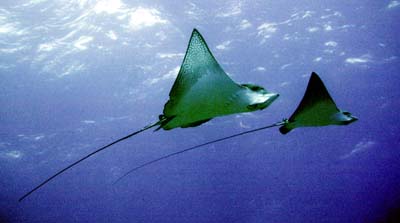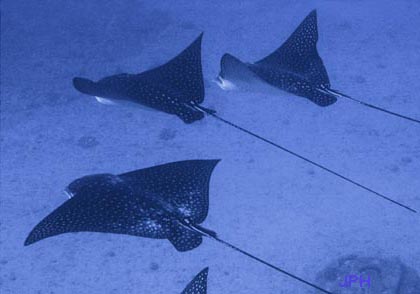|
hawaiisfishes.com
|
|
Home |
Fishes | Invertebrates |
Books | CDs
| Links |
Contact |
|
past
fishes of the month SPOTTED
EAGLE RAY
|
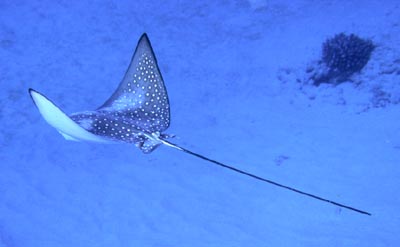 Kahe Point. O`ahu. 20 ft. |
|
SPOTTED EAGLE
RAY · hailepo; hihimanu |
|
|
| Eagle
Ray reproduction Spotted Eagle Rays pursuing one another may be about to mate. Writer/photographer Rod Canham describes "a large eagle ray hotly pursued by two smaller ones" at Molokini Islet, Maui. "The male latched onto the larger female and coupled 10 feet in front of us, as the pair rapidly glided out of sight." Dr. Tim Tricas of the University of Hawai`i observed two episodes of unsuccessful courtship at Enewetak Atoll, Marshall Islands. In the first instance two males swam behind a female on either side, nipping at her posterior margin. The female rose to the surface and vigorously slapped her wings on the water causing the males to back off. When she submerged the males continued to follow and nip. Occasionally one would swim wide circles around her. In the second episode, Tricas watched as a single male followed a female, periodically gouging her back with his dental plates and attempting to mount her. At each attempt she either shied to one side or surfaced. When she swam at the surface, the male followed either swimming conspicuously from side to side or up and down. Eventually the female left and the frustrated male swam in a wide circle alternately surfacing and diving at a 45 degree angle, his white underside producing bright "flashes" visible even after the outline of the ray disappeared in the distance. In their book Sharks and Rays of Hawai`i (Mutual Publishing, 2002), Gerald L. Crow and Jennifer Crites write: "In Hawai`i, spotted eagle rays are born in October, November and December in Pearl Harbor and Kane`ohe Bay, O`ahu, and on the leeward side of Moloka`i. During the birthing process, these rays have been seen leaping from the water and dropping their young in midair." Up to four pups (disc width 10-20 inches) are born per litter. |
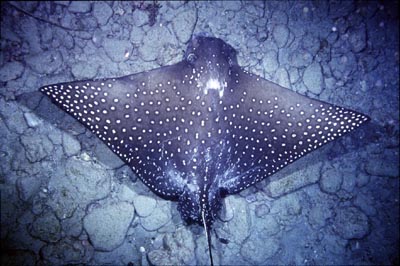 |
|
Eagle
Ray feeding |
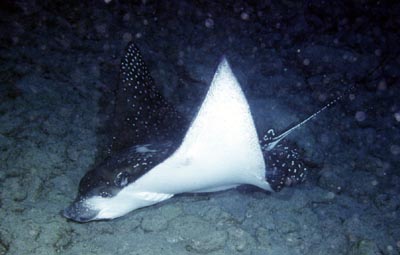 "scanning" for prey - Lana`i Lookout, O`ahu. 30 ft. |
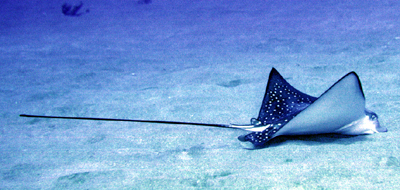 "scanning" for prey - Kahe Point, O`ahu. 30 ft. |
| Spotted
Eagle Rays as food Sharks are the main predators of Spotted Eagle Rays. Species known to feed on them in other parts of the world include the Silvertip Shark(Carcharhinus albimarginatus) and Great Hammerhead (Sphyrna mokarran). Although neither of these is common in Hawaiian waters, the Tiger Shark (Galeocerdo cuvier) is. Consider the following story by Matthew D'Avella of Dive Makai Charters in Kailua-Kona, Hawai`i: "Kendra and I had heard word of a tiger shark that had taken a liking to Honokohau Small Boat Harbor. One day after multiple sightings of the shark at the mouth of the harbor, Kendra, our friend and co-worker Mark, and I, decided to do a beach dive at "Manta Ray Bay" just outside of the Harbor in hopes of catching a glimpse of this beautiful animal. We entered the water at about 4:00 in the afternoon. About 10 minutes into the dive we reached the pinnacle, about 45 feet deep, and came upon an eagle ray. I later named him Ray Ray. I got the idea that if I stayed close to the ray, and the shark came to visit, then the ray might be a more tempting meal for the shark than me. Besides, the ray was obliging my wishes and was staying close to me too. For the next 20 minutes I shot video of Ray Ray swimming and digging in the sand for food or facing me and looking at me. He was just staring at me, it was almost creepy to be looking at his face. At times he was swimming so close to me that I could not get his entire body in the view screen, or if I did get the shot, I had my fin tips at the bottom of the video because I was having to swim backwards to get away from him. Towards the end of my encounter with Ray Ray I met up with Mark and Kendra again. Kendra grabbed my hand and had me feel her heart beat. To call her heart beat "racing" would be an understatement. She is a very small girl and I could feel her heart beating quite powerfully through her double 7mil wet suit. We headed back into the beach and we surfaced in 5 feet of water and Kendra told me of her encounter with the tiger shark. Kendra said that the shark swam right over her head, close enough to touch. She got two outstanding photos of the tiger shark which later became known as Laverne. Kendra then proceeded to tell me of what she saw of my encounter with the eagle ray. It seems that while I was using the ray for cover from the shark, the ray was using me for the same reason. Laverne and Ray Ray were playing 'ring around the diver', and I didn't know it. All that I saw was the ray, and all that I thought was "this video is going to be GREAT!" Well the video of Ray Ray is outstanding. I have some good shots of him feeding and swimming around me. After watching the video a few times, I started to notice some jerking motions from Ray Ray, was this in an effort to hide from Laverne? I suspect yes. Should I ever get the chance to see an eagle ray up close and face to face again, I am sure that I will feel an urge to turn and look behind me. After all, I am a firm believer that my bravery in the ocean realm is directly related to the amount of tape and remaining battery power in my camera." Matthew J D'Avella Dive Makai Charters Kona Hawaii |
|
|
|
What
does a Spotted Eagle Ray do all day? b)
Commute c)
Feed and socialize d)
Go home |
|
Interesting
factoids |
|
|
